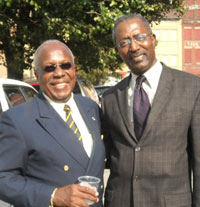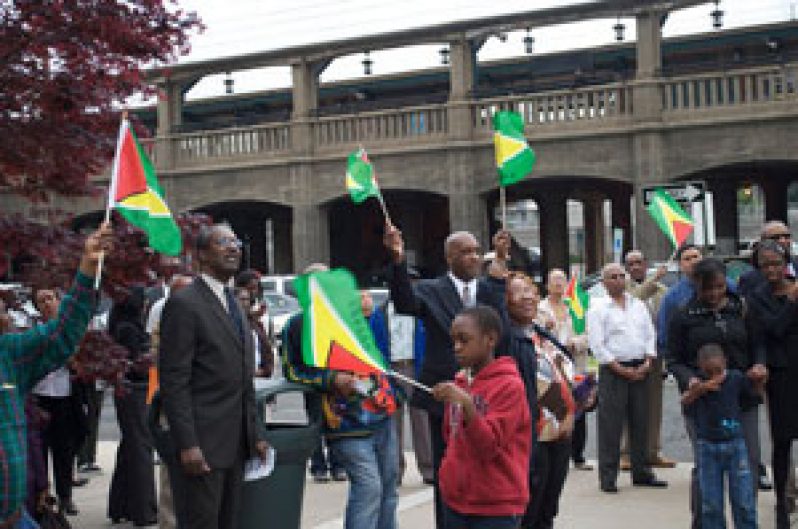WHEN the Golden Arrowhead was hoisted for the first time, on the dawning of Guyana’s Independence Day on May 26th 1966, Second Lieutenants Desmond Roberts and Ulric Pilgrim of the Guyana Defence Force were selected to do the honours.
 Forty-seven years later, via Facebook, Guyana Chronicle interviewed the retired Colonel Roberts from his home in the USA, and this is what he had to say about events on that historic night:
Forty-seven years later, via Facebook, Guyana Chronicle interviewed the retired Colonel Roberts from his home in the USA, and this is what he had to say about events on that historic night:
“There was much anxiety during the rehearsals, as construction of the National Park was in progress for the Independence celebrations, and the practice of hoisting the flag was being done with a small flag. On the night of the parade, I was instructed by the Parade Commander that fellow Lieutenant Ulric Pilgrim was assigned to assist me to hoist the Golden Arrowhead.” Roberts said he wondered why, but obeyed the instruction given as the moment all Guyana was waiting for approached.
Thousands had gathered to witness this historic moment, and the parade moved off, smartly attired and moving in precision onto the square of the National Park. The moment had arrived when Guyana’s Golden Arrowhead was to be unfurled for the first time ever. He said he remembers there was no Northern Stand then, and the wind blowing in from the Atlantic was heavy that night.
The flag to be hoisted was not the same one with which they had done rehearsals; this one was taking a long time to be unfurled. As the Union Jack was being lowered, the Golden Arrowhead was rising limply up the flagpole. As it reached the top, the winds became fiercer, and the two lieutenants struggled to get the flag to open. When it finally did, the two officers were surprised that the Golden Arrowhead was larger than they had anticipated. And there it was, flying at right angles, displaying its impeccable beauty for all the world to see!
Fireworks and a 21-gun salute erupted with the joyous shouts emanating from all around the National Park. Then the  National Anthem began to play.
National Anthem began to play.
From where he was, he could see the late leaders – Forbes Burnham and Dr Cheddi Jagan – embracing in a hug that was to be symbolic of all the hopes and dreams of the Guyanese people…
About Desmond Roberts
Desmond Roberts attended the La Retraite Church of Scotland Primary School, before going on to the British Guiana Educational Trust College, after which he entered the Queen’s College Cadet Corps.
With the love and passion for the military and his country at that time in his life, he began his military career after completing his ‘A’ levels and working for a brief period at the Statistical Bureau.
Roberts was among the first officers of the British Guiana Special Services Unit to receive training at the Mons Officer Cadet School in the United Kingdom. On his return from that stint, he was given the option to join the newly-formed Guyana Defence Force (GDF).
Roberts served at the border location of Eteringbang in Guyana’s North West District.
In 1967, Roberts organised the first GDF athletics sports.
After serving at Eteringbang for a brief period, he was appointed officer in charge of the No 4 Company in 1968, and in early 1969, he assumed command of the company during the Rupununi Uprising.
His appointment as General Staff Officer Two in 1970/1971 and second in command of the Second Battalion in 1972 are among some of his rapid promotions and appointments.
He was promoted to the rank of Major in 1973 and was appointed the first military director of the Guyana Youth Corps, and later Assistant Director General of the Guyana National Service in 1974.
In 1976, he was promoted to Deputy Director General of the Guyana National Service, and served as Director General from 1979 to 1981.
He also served as non-resident Military Attaché to Brazil during the period 1982/84, and functioned out of the Defence Secretariat in 1984, discharging the responsibility of coordinating the North Korean, Guyanese and UNEP consultant teams constructing the small Eclipse Falls Hydro-Project.
In 1986, he served as Commander, Administration and Logistics, until 1990, when he retired.
He also served as president of the Amateur Athletics Association of Guyana from 1976 to 1979 and from 1986 to 1989, managing a team to the Seoul Olympics in 1988. Moreover, he served as president of the Masters Athletics Association from 1982 to 1989, and as vice president of the Guyana Badminton Association.
Roberts says that whenever he sees a Golden Arrowhead flying anywhere in the world, as a true patriot of his country and one who really loves Guyana, he feels nostalgic. “Over the years, I have been invited to a number of Guyana’s Independence anniversary celebrations around the world, and whenever it comes to the moment when the Golden Arrowhead must be raised, I remember that first historic event.
“It is only when you travel to other countries that you realize the variety of foods we have in Guyana, and the harmonious mix of ethnicities in our beautiful country.”
Long live Guyana! Long live our people of six races! Long live the Golden Arrowhead, I concluded as we ended the interview.



.jpg)









